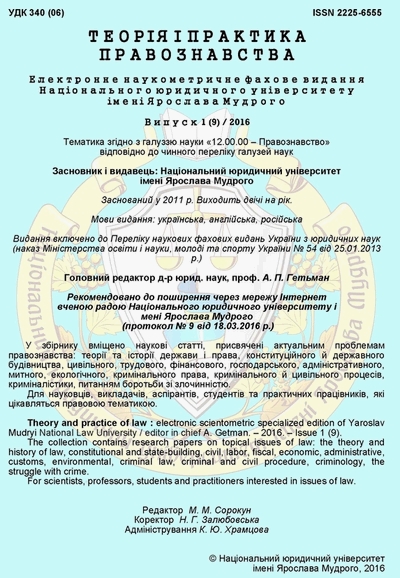Regional human hair: іnformation for interpretation in the jurisprudence
DOI:
https://doi.org/10.21564/2225-6555.2016.1.64268Keywords:
regional human hair, macroscopic and microscopic examination, specific micromarfocomplexAbstract
Problem Setting. Hair is one of the objects of research as evidence in a criminal cases are related with the investigating of murder, theft, sex crimes, searching of a missing persons, traffic accidents and others.
The actuality of the topic. Over the last 100 years the microscopic examination of human hair was one of the accessible way of identification some connection between two people or human and subject (evidence). In the past 75 years this examination conducted in forensic – examination laboratories and recognized officially in academic and law enforcement circles.
The purpose of the article. During this type of expert examination the forensic expert explores not only the hair on the human head and with other anatomical areas of the body. One of the key issues is to establish the origin of human hair and distinctive marks of the objects. This diagnostic value based on the morphological signs researching. Therefore it is necessary to create a general table of human hair origin differentiation based on macro and micro morphological signs. It will help reduce the time practicing experts in search of signs specific group of human hair and simplify the differential diagnosis of origin.
There is a fact that a human hair from a different anatomical regions of the body has a constant hallmark, therefore it is possible to conduct their comparison. But the process of reliable definition of areas on the body and origin of human hair very difficult, there is a lot of circumstance such as: specific regional characteristics are not always clearly marked; some of them may be specific to different regional groups, human hair. It should be noted that hair different anatomical areas of the body not unique to the individual morphological signs as well as some combination - it is specific mikromorfocomplex of signs. So at research of regional human body hair necessary to establish a specific set of characteristic morphological features, this gives grounds for establishing their regional origin.
Conclusions. The expertise of the hair can not resolve the question of human identity. But micro and macroscopic examination can be thorough evidence base which proves innocence of the person.
Above mention information we come to a conclusion that the main part of characteristic signs for resolving the issue of regional origin of human hair can be obtained in its micro and macroscopic analysis. First of all should thoroughly study micro and macro morphology of the human hair and mark the specific characteristics of the human hair regional originReferences
Razumov, E. A., Moliboga, N. P. (1994). Osmotr mesta proisshestviya. Kiev: RIO MVD Ukraina [in Russian].
Oien, Cary T. (2009). Forensic Hair Comparison: Background Information for Interpretation. Forensic Science Communications, vol. 11, 2. Retrived from: https://www.fbi.gov/about-us/lab/forensic-sciencecommunications/fsc/oct2009/review/2009_04_ review02.htm.
Scientific Working Group on Materials Analysis Forensic Human Hair Examination Guidelines. Forensic Science Communications, vol. 7, 2. (2005). Retrived from: https://www.fbi.gov/about-us/lab/forensic-sciencecommunications/fsc/april2005/standards/2005_ 04_standards02.htm.
Tumanov, A. K. (1972). Metodyi sudebno-meditsinskogo issledovaniya volos. Sudebno-meditsinskaya ekspertiza, 1, 28–31 [in Russian].
Matyisheva, A. A. (Ed.) (1998). Sudebnaya meditsina: rukovodstvo dlya vrachey. Sankt Peterburg: Gippokrat, 459–462 [in Russian].
Kisin, M. V., Bulyishova, L. K., Mamotyuk, M. L. (1984). Razorenova Volosyi zhivotnyih kak ob'ekt sudebno-biologicheskoy ekspertizyi. Moskva: VNII MVD SSSR, 3-4 [in Russian].
Avdeeva, I. A., Vasileva, O. O. (2006). P. A. Minakov i razvitie sudebno-meditsinskoy ekspertizyi volos v Rossii. Zdorove i obrazovanie v XXI veke, 1, vol. 8, 15 [in Russian].
Nadezhdin, V. A. (1927). Sudebnaya meditsina v voprosah i otvetah. – Leningrad: Rabochiy sud, 29–32 [in Russian].
Tumanov, A. K. (1961). Sudebnomeditsinskoe issledovanie veschestvennyih dokazatelstv. – Moskva: Gosyurizdat, 458–574 [in Russian].
Avdeev, M. I. (1949). Sudebnaya meditsina. – Moskva: Gosyurizdat, 473–479 [in Russian].
Barsegyans, L. O. Vereschaka, M. F. (1982). Morfologicheskie osobennosti volos cheloveka v aspekte sudebno-meditsinskoy ekspertizyi. – Moskva: Meditsina, 7–21 [in Russian].
Tomilin, V. V., Barsegyans, L. O. & Gladkih A. S. (1989). Sudebno-meditsinskoe issledovanie veschestvennyih dokazatelstv. Moskva: Meditsina, 269–288 [in Russian].
Zimina, Yu. V. (2008). Differentsialnaya diagnostika volos anatomicheskih oblastey cheloveka po mikromorfologicheskim priznakam. Sankt-Peterburg: Izd-vo SPbMAPO, 14–25 [in Russian].
Prozorovskogo, V. I. (Eds.). (1968). Sudebnaya meditsina. Retrieved from http://medlec.org/lek-88997.html [in Russian].
Sudebno-meditsinskoe issledovanie volos. Retrieved from: http://www.medical911.ru/sudebno-meditsinskoe-issledovanie-vo/ [in Russian].
Kirk, Paul L. (1940). Human Hair Studies: General Considerations of Hair Individualization and Its Forensic Importance. Am. Inst. Crim. L. & Criminology, Vol. 31, 486–496.
Human and Animal Hair Examination. Retrieved from: http://www.forensicsworld.com/csichallenge/2015/docs/Hair.pdf.
Deedrick, Douglas W., Koch, Sandra L. (2004). Microscopy of Hair. Part 1: A Practical Guide and Manual for Human Hairs. Forensic Science Communications, Vol. 5, 1. Retrieved from: https://www.fbi.gov/about-us/lab/forensic-sciencecommunications/fsc/jan2004/research/2004_01_ research01b.htm.
Vinayak, V., Chitralekha, S., Kaur, S., Kadyan, A. and Rai, A. (2012). Forensic Trichology And Its Importance In Crime. Nature and Science, Vol. 10 (9), 116–120.
Downloads
Published
How to Cite
Issue
Section
License
Copyright (c) 2016 Теорія і практика правознавства

This work is licensed under a Creative Commons Attribution 4.0 International License.




